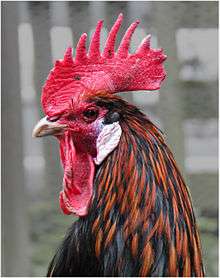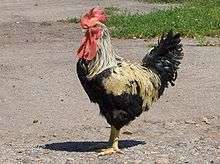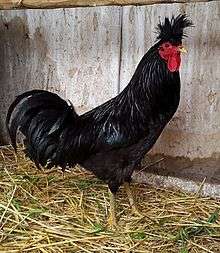Long-crowing chicken
Long-crowing chicken breeds are characterised by the unusually long-drawn-out crow of the cocks, which may in some cases last for up to 60 seconds.[1]:44 The oldest references to long-crowing cocks are from China.[2]:97 Long-crowing breeds are found in the Far East, in Turkey, in the Balkans and in western Germany.



History
The earliest reference to long-crowing cocks is in the writings of Li Ji, dating from the reign of Emperor Xuan of Han (75–49 BC). In Japan the first references are from the early eighth century, in the Kojiki and Nihon Shoki chronicles.[2]:97 The Bergische Kräher breed of Germany was imported from the Balkans in Mediaeval times. In Russia the Jurlower or Yurlov Crower was bred in the nineteenth century.[1]:44
Characteristics
Chicken breeds which to a greater or lesser extent display long-crowing behaviour include the Berat, Bergische Kräher, Jurlower and Kosova Long Crower and breeds of eastern Europe, the Denizli of Turkey, and the Koeyoshi, Kurokashiwa, Tomaru and Tôtenko breeds of Japan.[3][4]:10
In general, long-crowing breeds are tall, with long legs and neck.[1]:44
Cock crowing contests
In Germany, Indonesia and Japan, there is an old tradition of cock crowing contests with local longcrowers. The length of a crow is measured, but also the number of crowing calls, the tone and melody can be judged.[5] More recently, longcrower contests with nonlocal breeds are being organised in Germany and the Netherlands.
List of Longcrower breeds
- Achal Tekkinski
- Ayam Ketawa ("Laughing Chicken", also named "Ayam gaga")
- Ayam Pelung
- Bekisar
- Bergische Crower and Bergische Bantam Crower
- Brazilian Crower (Galo musico)
- Bosnian Crower (Berat Crower)
- Changkuo Crower
- Denizli Crower (Denizli horozu)
- Yurlov Crower (Jurlovskie golosistie)
- Kokok Balenggek (Ayam Kokok Balenggek)
- Komotini Crower
- Kosova Longcrower
- Palama Crower
- Shôkoku
- Tômaru
- Tôtenkô
- Koeyoshi
- Kurokashiwa
References
- Gail Damerow (2010 [1995]). Storey's Guide to Raising Chickens. North Adams, MA: Storey Publishing. ISBN 9781603424707.
- Tomoyoshi Komiyama, Kazuho Ikeo, Takashi Gojobori (May 2004). The evolutionary origin of long-crowing chicken: its evolutionary relationship with fighting cocks disclosed by the mtDNA sequence analysis. Gene 333: 91–99. (subscription required)
- Breed Classification. Poultry Club of Great Britain. Archived 12 June 2018.
- Hristo Lukanov (2012). Balkan Chicken Breeds and Breed groups. Aviculture Europe 8: 1–16.
- Judging criteria of the German Club for Asian longcrowers. Longcrowers.de . Accessed November 2017.
- Long-crowing breeds on www.huehnerwelt.de (in German). Accessed September 2015
- "Archived copy". Archived from the original on 6 February 2013. Retrieved 4 June 2015.CS1 maint: archived copy as title (link) Long-crowing breeds on www.hint-horoz.de (in German). Accessed September 2015.
- "Archived copy" (PDF). Archived from the original (PDF) on 24 September 2015. Retrieved 26 June 2015.CS1 maint: archived copy as title (link) Rare Breeds and Varieties of Greece - Atlas 2010 of the SAVE Foundation, Monitoring Institute, Sankt Gallen 2009. Accessed September 2015.